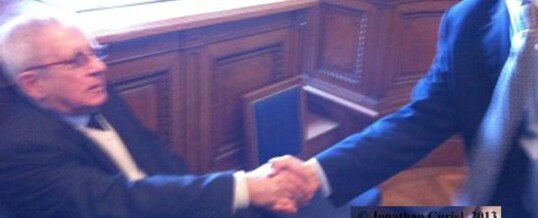
Author: Veronique Chemla | Re-posted with permissions | Article originally appears here.
 The man who uncovered the Al-Dura video fraud is still being tried for defamation.Updated article.
The man who uncovered the Al-Dura video fraud is still being tried for defamation.Updated article.
My article is perfectly and kindly translated in English by Michel Gurfinkiel forPajamas Media.
My original article is published in French on my blog
What will the Court of Appeals of Paris decide about Philippe Karsenty— the deputy mayor of Neuilly, director of the Media Ratings rating agency, and foreign affairs head of the French Liberal Democratic Party (a free-market party)?
 Will it hold him fully guilty of defamation against France Televisions (the umbrella organization behind France’s many state-owned TV channels) and Charles Enderlin, the state-owned France 2 channel chief correspondent in Jerusalem? Or will it release him once and for all based on the fact that he had the right to defame them because he had enough material to substantiate his accusations?
Will it hold him fully guilty of defamation against France Televisions (the umbrella organization behind France’s many state-owned TV channels) and Charles Enderlin, the state-owned France 2 channel chief correspondent in Jerusalem? Or will it release him once and for all based on the fact that he had the right to defame them because he had enough material to substantiate his accusations?
The recent Court hearings on January 16 were about this ultimate question.
Karsenty, one will remember, claimed that the infamous TV report on the killing in cold blood by Israeli soldiers of Palestinian boy Mohamed al-Dura — as it was released on September 30, 2000, by France 2 under Enderlin’s supervision — was a media hoax. Technically, such words can either be understood as defamation under French law, or accepted as legitimate criticism of the way the report was conducted, edited, and distributed worldwide.
The hearings took place in a special atmosphere: Paris was in the middle of a biting cold wave; one could feel it even at the majestic Palais de Justice near Notre Dame cathedral. Then there was the Al-Dura file itself, the ever-increasing suspicion about the report, the concern about Enderlin’s image. A feeling that some kind of censorship was at work, one way or the other, and that taboo issues were at stake. Also, a widespread fear that some of the people involved might engage in legal procedure almost at will.
 You could also notice a measure of irritation with Karsenty, along with the growing questioning of “Pallywood,” “Hezbollywood,” “Syriawood,” and almost any other Mideast production.
You could also notice a measure of irritation with Karsenty, along with the growing questioning of “Pallywood,” “Hezbollywood,” “Syriawood,” and almost any other Mideast production.
SNJ, the French journalists union, requested its members attend the hearings in order to grant support to Enderlin, yet very few turned up for the six-hour Court session. Daniel Bilalian and Vincent Nguyen from France 2 were there, as well as Emilie Raffoul of Canal+[1].
However, the top echelon of France Televisions, who had attended aprevious Court session on February 27, 2008, was conspicuous by its absence. So were the French Jewish media.
On the other hand, there was a large audience present, including VIPs like Richard Prasquier, the chairman of Crif (the Representative Council of French Jewish Organizations). JSS News, an Israel-based online magazine, covered the hearings live.
——————–
Before the hearings start, Karsenty approaches Enderlin and shakes hands with him. They chat briefly.
The president of the Court, Jacques Laylavoix, sums up the case and the procedure. Reading from stapled sheets of paper, he mentions — quite amazingly — “the Israeli positions” (plural) at the Netzarim crossing in the Gaza Strip. A factual error to be found in earlier Court decisions as well as in the submissions of Enderlin and France Televisions. It appears the judges repeated the plaintiffs’ error.
——————–
Both in the report broadcast by France 2 on September 30, 2000, and in the reels undersigned by Talal Abu Rahma, the Palestinian cameraman, Enderlin says:
 “3:00 PM … Everything turns upside down near the colonial settlement of Netzarim in the Gaza Strip… Here, Jamal and his son Mohamed are targeted by shootings from the Israeli position (singular) … Mohamed is 12 years old … His father tries to protect him … He waves his hand … But a new burst of fire … Mohamed is dead and his father heavily wounded …”
“3:00 PM … Everything turns upside down near the colonial settlement of Netzarim in the Gaza Strip… Here, Jamal and his son Mohamed are targeted by shootings from the Israeli position (singular) … Mohamed is 12 years old … His father tries to protect him … He waves his hand … But a new burst of fire … Mohamed is dead and his father heavily wounded …”
Enderlin and Chabot’s reaction was to sue Karsenty for defamation. Karsentywas found guilty by the Court of Paris on October 19, 2006. He appealed. Upon his demand, the Court of Appeals of Paris requested on October 3, 2007, that France 2 present the report rushes. After viewing them, the Court released Karsenty on May 21, 2008. Moreover, it berated the respondent party.
However, the Court of Annulment, France’s highest authority in judicial matters, quashed the decision on technical grounds on February 28, 2012: it argued that the defender is supposed to produce evidence by himself.
The Court’s president asks Karsenty to introduce himself.
Then, he corrects the president’s aformentioned error: there was only one Israeli position at Netzarim crossing.
He reminds the Court about his political duties as deputy mayor of Neuilly (a posh surburban municipality in Greater Paris, of which Nicolas Sarkozy was mayor until being elected president) and as spokesman and person in charge for international affairs at the Liberal Democratic Party (nothing to do with the American Democrat party — they were the only ones in France to support Mitt Romney).
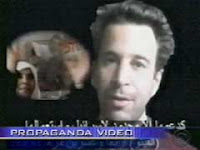 Then, he places the Al-Dura case within the global historical context and points to the controversial pictures’ “planet-wide impact”: from Osama Bin Laden, who used them to instill hatred among jihadists; to the video featuring the slaughtering by jihadists in Pakistan of the American journalist Daniel Pearl, inlayed with the face of Mohamed Al-Dura; to the French jihadist Mohamed Merah, who ascribed his killing spree in Montauban and Toulouse in March 2012 to a will to avenge the Palestinian boy:
Then, he places the Al-Dura case within the global historical context and points to the controversial pictures’ “planet-wide impact”: from Osama Bin Laden, who used them to instill hatred among jihadists; to the video featuring the slaughtering by jihadists in Pakistan of the American journalist Daniel Pearl, inlayed with the face of Mohamed Al-Dura; to the French jihadist Mohamed Merah, who ascribed his killing spree in Montauban and Toulouse in March 2012 to a will to avenge the Palestinian boy:Back in 2002, I, like many other people, just held as wholly unthinkable that France 2, the French public television, would broadcast a false report, or make any mistake, especially within the framework of a report commented by Charles Enderlin. … He is seen in France as the voice of the Middle East. Dominique de Villepin is reported to have asked, just ahead of a press conference at the French embassy in Israel: “What does Charles think about it ?” One must remember how powerful Enderlin is as a character. He is a very convincing person. I would dare to say that he is the Middle East’s Thierry Roland.
(Dominique de Villepin is a former conservative foreign minister and prime minister of France. Thierry Roland was for decades the number one TV commentator on sports in France.)
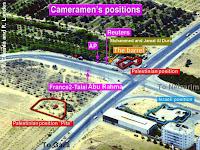 Karsenty reminds the Court about Enderlin’s political friends: Jacques Chirac, the former president of France; Bertrand Delanoë, the mayor of Paris. “And Shimon Peres,” Enderlin adds. Karsenty:
Karsenty reminds the Court about Enderlin’s political friends: Jacques Chirac, the former president of France; Bertrand Delanoë, the mayor of Paris. “And Shimon Peres,” Enderlin adds. Karsenty:As a matter of fact, I think that Enderlin is a victim. He is the victim of his cameraman, who supplied him with doubtful pictures. He is the victim of his own fame, which somehow prevented him to admit he had erred. He is the victim of his friends or of those who pass as his friends, who built around him a wall to protect him against the truth.
 Karsenty then explains how he gradually got involved in the ever-changing controversy, both through personal research and professional investigation undertaken within his agency’s activities.
Karsenty then explains how he gradually got involved in the ever-changing controversy, both through personal research and professional investigation undertaken within his agency’s activities.Karsenty starts his presentation by quoting “La Charte des Antennes de France Television” [2], the ethical and deontological charter of France Televisions.
He then displays samples from France 2 news programs devoted to the Al-Dura case and its legal developments as evidence that the channel did not just report facts or events, but actually distorted them in its own interest.
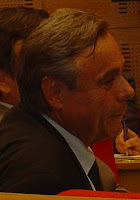 Moreover, he mentions that Senator Jean-Pierre Plancade, the deputy chairman of the French Senate’s commission on Culture, Education and Communication, quoted another deontological code — the “Charte du Groupe Audiovisuel Public (Charter for Public Broadcasting)” — on July 12, 2010, in a question to Remy Pfimlin, then a candidate to France Televisions’ chairmanship.
Moreover, he mentions that Senator Jean-Pierre Plancade, the deputy chairman of the French Senate’s commission on Culture, Education and Communication, quoted another deontological code — the “Charte du Groupe Audiovisuel Public (Charter for Public Broadcasting)” — on July 12, 2010, in a question to Remy Pfimlin, then a candidate to France Televisions’ chairmanship.As he did in the 2008 hearings, Karsenty displays evidence that on October 1, 2000, France 2 broadcast as a factual report complete with comments by Enderlin a mere staging by Gaza militants. The respondent party looks embarrassed.
Karsenty then displays more samples to establish that anonymous Palestinians were staging various war sketches at Netzarim crossing on September 30, 2000, the very day of Mohamed Al-Dura’s alleged killing, and shows how these playlets were staged in order to pass as real incidents and as evidence of tension on the ground. He lists the famous Al-Dura report’s many contradictions.
He insists on the unlikelihood of many parts of the report: no blood on the sidewalk, the walls, or the alleged victims’ clothes, almost no bullet impacts on the wall after what was a supposedly 45-minute shooting, and so on.
He stresses that there are many contradictions between Enderlin’s and Abu Rahma’s narratives on the Netzarim shooting. Regarding the Palestinian cameraman, Karsenty reminds the Court that he said on April 2, 2001, in an interview with Le Matin du Sahara, that “he made a decision to become a journalist in order to uphold the Palestinian cause.”
All in all, Karsenty speaks for about an hour and one half (with one interruption by Enderlin on a factual point). To conclude, he quotes one of the two texts for which he is being sued: “Charles Enderlin erred and by his very erring led us into error.”
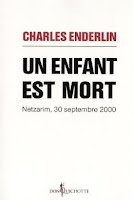
Did Enderlin ever entertain doubts about the cameraman? He says that he consulted the Shin Bet (Israel’s home security service) about Talal Abu Rahma, “who constantly goes out of Gaza.” He admits that Abu Rahma does not hold a press card anymore.
Enderlin admits that he made a mistake when he mentioned to Telerama (a magazine dealing with TV programs and cultural issues) that he edited out images showing “Mohamed al-Dura’s agony.” “Agony” (“agonie” in French, which means both “dying“ and “unbearable suffering”) was not the proper word to be used, even if the Littré dictionary (the French language’s most respected, but somewhat outdated dictionary) could be quoted to the contrary.
 Enderlin and France Televisions then use DVDs to make their point. They intend to show again the Al-Dura report and other films they already submitted in the 2008 hearings. Unbelievably, technical difficulties arise. Karsenty obligingly lends his own loudspeakers to allow for a proper sound level.
Enderlin and France Televisions then use DVDs to make their point. They intend to show again the Al-Dura report and other films they already submitted in the 2008 hearings. Unbelievably, technical difficulties arise. Karsenty obligingly lends his own loudspeakers to allow for a proper sound level.Some scenes had already been dissected by Karsenty, and had raised the audience’s hilarity.
As for the picture of a Palestinian child brought to the morgue on September 30, held by the plaintiffs as being Mohamed Al-Dura’s, Karsenty establishes on sheer chronological grounds that it must be another child.
Three witnesses speak on behalf of the appellant.
 Esther Schapira, a frequently awarded German journalist and filmmaker, explains that she devoted a first documentary movie to the Al-Dura case in 2002: Three Bullets and a Dead Child. She says she made sure to listen to both parties, and did not question then the images’ authenticity, even if she suspected the boy to have been killed by Palestinian gunmen rather than by Israeli soldiers.
Esther Schapira, a frequently awarded German journalist and filmmaker, explains that she devoted a first documentary movie to the Al-Dura case in 2002: Three Bullets and a Dead Child. She says she made sure to listen to both parties, and did not question then the images’ authenticity, even if she suspected the boy to have been killed by Palestinian gunmen rather than by Israeli soldiers. Schapira says also that Karsenty visited her in Frankfurt in 2002, after her documentary was broadcast by ARD, and he viewed her rushes at length. This is an important statement as far as the appellant is concerned, since it confirms that he was already engaged in a serious investigation and already fully cognizant of the inconsistencies and contradictions of the France 2 report. The appellant’s lawyers will refer to it later on.
Dr. Patrick Bloch, war surgeon and medical expert, makes clear that children hit by bullets “don’t move, as a result of a specific traumatic shock, but stay in a state of sideration,” contrary to the allegedly wounded child shown in the France 2 report who does move. Moreover, bullets usually go through a human body and “always create a second visible wound as they go out,“ except when lodged in the head and the thorax, where they may remain. Also, the damage created by high-velocity bullets, either in terms of flesh or blood projection, is always significant, whereas no such necessary outcome of a shooting is to be seen in the report. If the femoral artery is hit — something that happened to the father, according to his own words — “blood runs out at a 300 to 600 milliliters per minute speed, which means that the wounded person is completely emptied of his or her blood in 10 minutes.” The father, Jamal al-Dura, is supposed to have been rescued by an ambulance after 20 minutes of bleeding.
The terse and sharp-minded public prosecutor Jean-François Cormaille de Valbray asks Dr. Bloch about a reddish spot he says he has noticed on Jamal al-Dura’s abdomen. The expert looks carefully at the spot. After some reflection on the matter, Dr. Bloch concludes that while it is likely to be just a color spot that popped up through image processing, it could be a blood stain as well.
 Jean-Claude Schlinger, aballistic expert to the Court of Appeals of Paris, was consulted in 2008 at Karsenty’s request, and built up his opinion on boththe report and additional evidence. From the “eight bullet impacts” that can be seen behind the Al-Dura persons, he concludes that the shootings cannot have originated from the Israeli position. From a 30° shooting angle, the impacts would have been oval-shaped rather than round — and a 45-minute non-stop shooting is totally unbelievable. Schlinger goes so far as to admit that the whole thing “may have been staged.” Cormaille de Valbray asks: “How can one say that the people who hit the Al-Duras were not snipers, who shot bit by bit?“
Jean-Claude Schlinger, aballistic expert to the Court of Appeals of Paris, was consulted in 2008 at Karsenty’s request, and built up his opinion on boththe report and additional evidence. From the “eight bullet impacts” that can be seen behind the Al-Dura persons, he concludes that the shootings cannot have originated from the Israeli position. From a 30° shooting angle, the impacts would have been oval-shaped rather than round — and a 45-minute non-stop shooting is totally unbelievable. Schlinger goes so far as to admit that the whole thing “may have been staged.” Cormaille de Valbray asks: “How can one say that the people who hit the Al-Duras were not snipers, who shot bit by bit?“Schlinger’s reply is even terser: “Because the cameraman said otherwise”.
The actual pleading starts in the afternoon. Under French law [3], the defendant in a defamation case is released if he can prove that his assertions are true, or that he acted in good faith. And good faith, in turn, needs four conditions under French case law to be established: a serious preliminary investigation; a legitimate aim; caution in the wording; and the absence of personal enmity. More often than not, release is granted under an assumption of good faith.
Maître Bénédicte Amblard, counsel for France Televisions and Charles Enderlin, faintly denounces “a media destruction undertaking,” labors to establish that defamation is “well-established,” argues that Karsenty has no access in 2004 to any information that would substantiate his statements, and requests him to be found guilty and “legally publicized as such … in order to turn the page.” She says that a book and a movie will be available shortly.
Prosecutor Jean-Francois Cormaille de Valbray reminds the Court that it does not rule on “historic truth” in “a difficult, sensitive debate,” but rather on “the defamatory character of the incriminated remarks.” He leaves it to the Court to decide, just as he did previously in Jamal al-Dura’s suit against Dr. Yehuda David, an Israeli witness, and Clément Weill-Raynal, a French journalist.
 Maître Delphine Meillet and Maître Patrick Maisonneuve, Karsenty’s counsels, claim on behalf of him “a strategy” of deliberate, yet legitimate, “provocation.” According to them, it was the only way to crush the media silencing of any questioning about the reality of the France 2 report’s allegations[4]. They mention case law precedents allowing “for the sake of the public interest” either “immoderate remarks” or “an amount of exaggeration, or even of provocation” in remarks (in particular a Court of Annulments decision from February 3, 2011).
Maître Delphine Meillet and Maître Patrick Maisonneuve, Karsenty’s counsels, claim on behalf of him “a strategy” of deliberate, yet legitimate, “provocation.” According to them, it was the only way to crush the media silencing of any questioning about the reality of the France 2 report’s allegations[4]. They mention case law precedents allowing “for the sake of the public interest” either “immoderate remarks” or “an amount of exaggeration, or even of provocation” in remarks (in particular a Court of Annulments decision from February 3, 2011).To keep it short, Philippe Karsenty “conveniently broke the law in the interest of our democracy.” What he did can be described as “defamation without personal enmity, with a legitimate object, in good faith, substantiated by a serious and protracted investigation drawing from different sources.”
There is a light moment as Maître Delphine Meillet sarcastically quotes some certificates put forward by the respondent party in order to validate previous certificates delivered by Palestinian cameramen[5].
The Court will deliver its judgment on April 3, 2013.
 An incident occurs right after the hearings, as people are leaving the courtroom. It does not involve the parties. In an adjacent hall, Charles Enderlin calls Esther Schapira “a militant journalist“ in English. He wonders why she interviewed only three of the twenty Israeli soldiers or so that were on duty at Netzarim on September 30.
An incident occurs right after the hearings, as people are leaving the courtroom. It does not involve the parties. In an adjacent hall, Charles Enderlin calls Esther Schapira “a militant journalist“ in English. He wonders why she interviewed only three of the twenty Israeli soldiers or so that were on duty at Netzarim on September 30.I reply: “Why did you not tell it to the Court?”
Enderlin shrugs. I insist: “You should have told it to your counsel, who in turn would have asked the Court.”
Finally, as I advance the view that “Talal Abu Rahma is a militant cameraman,” he goes away, in the custody of three people. One whispers to him: “They are filming you … “.
Thus, Arlette Chabot, the then director of news at France 2, said on November 16, 2004: “One will never know where the shootings came from. Was it from the Israeli or the Palestinian position?”
Nevertheless, and in spite of many revelations about other Mideast fabrications, Charles Enderlin unconvincingly sticks to his 2000 comments.
 Charles Enderlin claims he knows the place well. Still, being asked by Richard Landes about the Israeli position, he did not locate it accurately on a map.
Charles Enderlin claims he knows the place well. Still, being asked by Richard Landes about the Israeli position, he did not locate it accurately on a map.Moreover, he has resorted to puzzling details. During the present hearing, he said that the ambulance man attempted in vain to resuscitate Mohamed Al-Dura. Quite a new fact, it seems. How do we reconcile it with the France 2 report as it has been released, according to which the ambulance arrives after the child has been declared dead by the commentator? Was the ambulance man a doctor as well? Why did he engage into a resuscitation attempt? Everything is clouded in mystery. All the more so since Mohamed al-Dura must have been emptied of his blood in the course of an alleged 45-minute shooting.
Even if no blood is to be seen on the film.
Strangely enough, almost no French media saw to it to publish or quote the AFP dispatch about the January 16 hearing. Except Rue89, which published a rather partial piece.
On January 21, Charles Enderlin posted a factual account of the hearing, written at the third singular person, on his blog. He did not answer the questions raised by his report.
On February 11 and 12, 2013, Enderlin posted two articles: Esther Schapira and Esther in Gaza. He criticized Esther Schapira’s work.
On February 22, 2013, Esther Schapira posted her Open Letter to Charles Enderlin.
[1] Emilie Raffoul signed the Pour Charles Enderlin pétition (siding with Enderlin). Along with Stéphane Harment, she authored a TV report mentioning the Al-Dura controvesy that was broadcast on April 24, 2008 by Jeudi Investigation, a program on the French privately owned TV channel Canal+. Jeudi Investigation and Tac Presse were found guilty of defamation against Philippe Karsenty by the Court of Paris on June 10, 2010. The judgement was upheld by the Court of Appeals of Paris on January 5, 2012.
[2]http://www.francetelevisions.fr/downloads/charte_des_antennes_web.pdf. See page 50.
[3] According to the French Freedom of Press Act, passed on July 29, 1881.
[4] France 2 is one of France Televisions several TV channels.
[5] France 2 broadcast in 2002 one of Pallywood’s most egregious flops: a scene where the corpse of the alleged victim of an Israeli shooting rises from a stretcher and runs.
Veronique Chemla is an investigative journalist based in Paris. She also contributes to FrontPage Magazine and American Thinker, and posts at The Veronique Chemla Report.
Share

